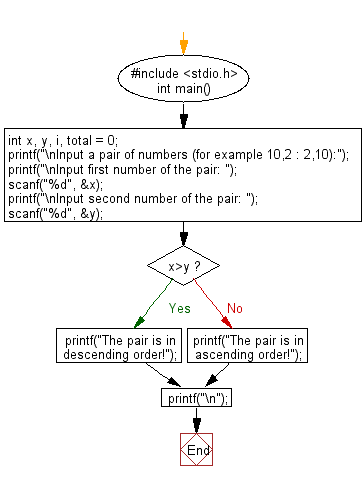C Exercises: Check whether two numbers in a pair is in ascending order or descending order
C Basic Declarations and Expressions: Exercise-35 with Solution
Write a C program to check whether two numbers in a pair is in ascending order or descending order.
C Code:
#include <stdio.h>
int main()
{
int x, y, i, total = 0;
printf("\nInput a pair of numbers (for example 10,2 : 2,10):");
printf("\nInput first number of the pair: ");
scanf("%d", &x);
printf("\nInput second number of the pair: ");
scanf("%d", &y);
if (x>y)
{
printf("The pair is in descending order!");
}
else
{
printf("The pair is in ascending order!");
}
printf("\n");
}
Sample Output:
Input a pair of numbers (for example 10,2 : 2,10):
Input first number of the pair: 10
Input second number of the pair: 2
The pair is in descending order!
Flowchart:

C Programming Code Editor:
Contribute your code and comments through Disqus.
Previous: Write a C program to compute the sum of consecutive odd numbers from a given pair of integers.
Next: Write a C program to read a password until it is correct. For wrong password print "Incorrect password" and for correct password print "Correct password" and quit the program. The correct password is 1234.
What is the difficulty level of this exercise?
Test your Programming skills with w3resource's quiz.
C Programming: Tips of the Day
Static variable inside of a function in C
The scope of variable is where the variable name can be seen. Here, x is visible only inside function foo().
The lifetime of a variable is the period over which it exists. If x were defined without the keyword static, the lifetime would be from the entry into foo() to the return from foo(); so it would be re-initialized to 5 on every call.
The keyword static acts to extend the lifetime of a variable to the lifetime of the programme; e.g. initialization occurs once and once only and then the variable retains its value - whatever it has come to be - over all future calls to foo().
Ref : https://bit.ly/3fOq7XP
- New Content published on w3resource:
- HTML-CSS Practical: Exercises, Practice, Solution
- Java Regular Expression: Exercises, Practice, Solution
- Scala Programming Exercises, Practice, Solution
- Python Itertools exercises
- Python Numpy exercises
- Python GeoPy Package exercises
- Python Pandas exercises
- Python nltk exercises
- Python BeautifulSoup exercises
- Form Template
- Composer - PHP Package Manager
- PHPUnit - PHP Testing
- Laravel - PHP Framework
- Angular - JavaScript Framework
- Vue - JavaScript Framework
- Jest - JavaScript Testing Framework
